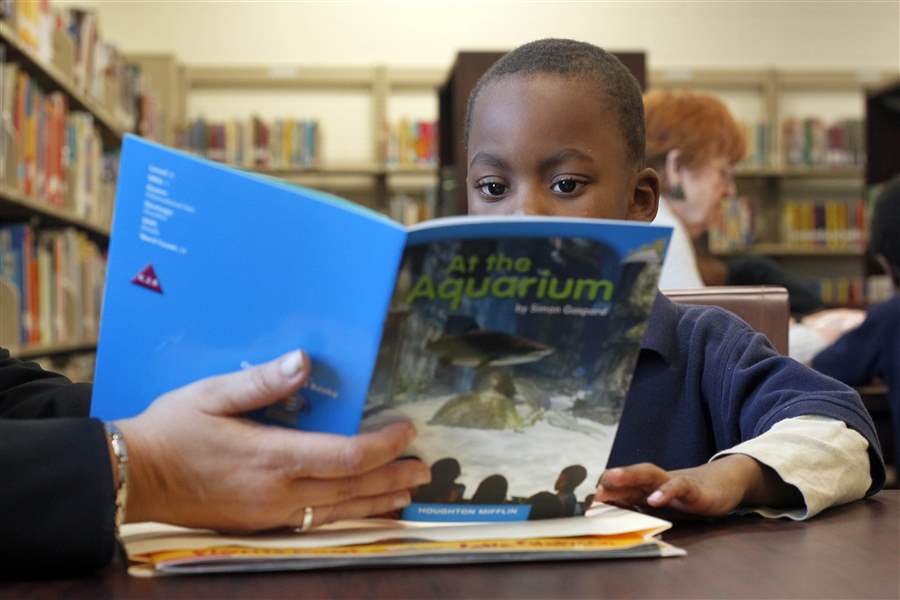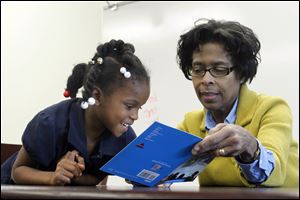
Program spreads joy of reading to elementary school students
11/15/2012
Ke’Mon Anderson shares a book about life at an aquarium with a tutor in the library of Pickett Elementary School. He is part of the ‘Creating Young Readers’ program.
The Blade/Amy E. Voigt
Buy This Image

Volunteer reader Doris Whatley and Kanijah Edwards read in the library of Pickett Elementary School. They are using a technique in which they take turns reading a book.
Doris Whatley and Nickia Madison huddled close, looking for animals on a book’s pages.
Ms. Whatley led the reading, about a rooster on a walk, and then let Nickia search. On this page, the pair found a turtle, which was quickly identified by the 5-year-old.
“Because I had one before,” she proudly exclaimed.
Page after page, Nickia pointed to the animals and read a smattering of words with her tutor. Page after page, Ms. Whatley couldn’t stop smiling.
Most days, Ms. Whatley spends her time working on computer systems for Toledo Public Schools. But on Wednesday at Pickett Academy, she spent part of her afternoon helping students learn to love reading.
Ms. Whatley and TPS Human Resources Director Stacey Scharf, on the other side of the library, served as one-on-one tutors as part of the Creating Young Readers program, a Read For Literacy initiative. Volunteers use a process called dialogic reading, where adult and child take turns reading and discussing picture books.
The program is now in more than 20 preschools and elementary schools, including Pickett, Glenwood, and Robinson in TPS, and has expanded from kindergarten to first grade in those three buildings. At Pickett, students in those grades get at least a 20-minute session of one-on-one tutoring a week, and many receive twice or three times the sessions.
The program is still new, but leaders say there are early results. Read for Literacy and TPS are collaborating on creating scientific measurements on the program’s effectiveness at the end of the year.
In the meantime, teacher surveys done by Read for Literacy show teachers say they believe the program has improved student preliteracy skills and enthusiasm for reading while also correlating with a reduction in incidents of student misbehavior.
“I think it’s beneficial one on one,” Pickett kindergarten teacher Patty Travis said of the program. “[The students] have to focus.”
And there’s preliminary evidence the program is having measurable academic benefits, Pickett’s assistant principal Ward Barnett said.

Ke’Mon Anderson shares a book about life at an aquarium with a tutor in the library of Pickett Elementary School. He is part of the ‘Creating Young Readers’ program.
Students who enter Ohio kindergartens take an assessment called the Kindergarten Readiness Assessment – Literacy, which gauges children’s skills in oral language, rhyming, letter identification, and alliteration, elements that are essential for reading. In later elementary grades, students periodically take formative assessments such as DIBELS, or Dynamic Indicators of Basic Early Literacy Skills.
Pickett students who participated in the Creating Young Readers program have had better baseline DIBELS results than anticipated based on their KRAL scores, Mr. Barnett said, and had continued improvement on each DIBELS benchmark. That’s a formal way of saying students in the program are improving their literacy skills better than should be expected.
But beyond the numbers, students just seem to like reading more, Mr. Barrett said.
“I think it does impact and improve the way they look at reading,” he said.
That’s really the goal of the Creating Young Readers, said Amy Clark, its elementary school coordinator. The tutoring program isn’t a substitute for in-classroom instruction. And the technique that CYR tutors use has shown the greatest positive impact on early learners’' oral language skills.
“We aren’t teaching kids to read,” she said. “We are teaching them to love reading.”
Read for Literacy hopes to expand the program to 450 children from 287 and needs about 200 more volunteers. Anyone interested in volunteering can contact Sara Mattson, coordinator of early literacy services, at 419-242-7323 or sara.mattson@toledolibrary.org.
Contact Nolan Rosenkrans at: nrosenkrans@theblade.com or 419-724-6086.